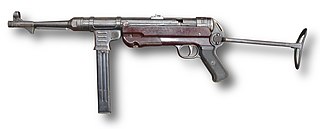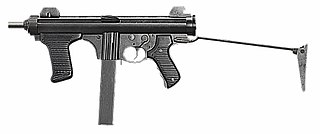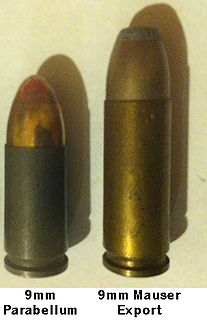Users
![]() Switzerland: The MP310 was adopted by Swiss police forces.
Switzerland: The MP310 was adopted by Swiss police forces.
![]() Chile: In service with Chilean Armed Forces and police.
Chile: In service with Chilean Armed Forces and police.
The SIG MP310 is a submachine gun manufactured in Switzerland, developed from SIG's earlier wood stock MP46 design. Its magazine was able to fold forward 90 degrees under the gun barrel, and it was fitted with a collapsible wire buttstock.
First introduced as the MP48 model in the late 1940s, the wood pistol grip and forestock were replaced in the 1950s with a polymer stock on the MP310. Production ended in 1972.
The SIG MP310's use of precision castings and high quality of manufacture made it an expensive weapon to produce; this expense may have contributed to it not being widely adopted.
![]() Switzerland: The MP310 was adopted by Swiss police forces.
Switzerland: The MP310 was adopted by Swiss police forces.
![]() Chile: In service with Chilean Armed Forces and police.
Chile: In service with Chilean Armed Forces and police.

A submachine gun, abbreviated SMG, is a magazine-fed, automatic carbine designed to fire handgun cartridges. The term "submachine gun" was coined by John T. Thompson, the inventor of the Thompson submachine gun, to describe its design concept as an automatic firearm with notably less firepower than a machine gun. As a machine gun must fire rifle cartridges to be classified as such, submachine guns are not considered machine guns.

The Uzi is a family of Israeli open-bolt, blowback-operated submachine guns and machine pistols first designed by Major Uziel "Uzi" Gal in the late 1940s, shortly after the establishment of the State of Israel. It is one of the first weapons to incorporate a telescoping bolt design, which allows the magazine to be housed in the pistol grip for a shorter weapon.

The MP 40 is a submachine gun chambered for the 9×19mm Parabellum cartridge. It was developed in Nazi Germany and used extensively by the Axis powers during World War II.
The Lanchester is a submachine gun (SMG) manufactured by the Sterling Armaments Company between 1941 and 1945. It is a copy of the German MP28/II and was manufactured in two versions, Mk.1 and Mk.1*; the latter was a simplified version of the original Mk.1, with no fire selector and simplified sights. It was primarily used by the British Royal Navy during the Second World War, and to a lesser extent by the Royal Air Force Regiment. It was given the general designation of Lanchester after George Herbert Lanchester, who was charged with producing the weapon at the Sterling Armaments Company.

The MP 18, manufactured by Theodor Bergmann Abteilung Waffenbau, was arguably the first submachine gun used in combat. It was introduced into service in 1918 by the German Army during World War I as the primary weapon of the Sturmtruppen, assault groups specialized in trench combat. Although MP 18 production ended in the 1920s, its design formed the basis of most submachine guns manufactured between 1920 and 1960.

The Type 100 submachine gun was a Japanese submachine gun used during World War II and the only submachine gun produced by Japan in any quantity. It was made in two basic variants referred to by American and British observers as the Type 100/40 and the Type 100/44, the latter also known as the Type 100 (simplified). A small number of the earlier version were converted into using folding stock, sometimes referred to by the Allies as the Type 100 navy, which was made for parachutists.

The Beretta M12 is a 9×19mm Parabellum caliber submachine gun designed by Beretta. Production started in 1959, the first users were the Italian Carabinieri, Italian State Police and the Guardia di Finanza, though in limited number, it was only widely issued beginning in 1978, replacing the old Beretta MAB. In 1962 the Italian Army bought a limited number of Franchi LF-57 submachine guns, judged better than the M12 but never issued to the troops, and only in 1992 the M12S2 variant was introduced, in very limited number. The Italian Air Force, instead bought many M12S and M12S2 for the airport security units. However the weapon had a higher initial success in the Arab countries and South America.

The FAMAE SAF is a submachine gun produced and manufactured by FAMAE since 1993.
The MP34 is a submachine gun (SMG) that was manufactured by Waffenfabrik Steyr as Steyr-Solothurn S1-100 and used by the Austrian Army and Austrian Gendarmerie and subsequently by units of the German Army and the Waffen SS, in World War II. An exceptionally well-made weapon, it was used by some forces well into the 1970s.

The SIG MG 710-3 is a Swiss 7.62 mm general-purpose machine gun (GPMG) designed and manufactured by SIG - Schweizerische Industrie Gesellschaft. The weapon was developed as a commercial venture primarily for export, since the Swiss Army had already adopted the 7.5 mm MG 51 GPMG, produced by the federal arms factory W+F.
The SG 540 is a 5.56×45mm NATO assault rifle developed in the early 1970s by Schweizerische Industrie Gesellschaft of Neuhausen, Switzerland as a private venture primarily destined for export markets and as a potential replacement for the 7.5×55mm Swiss SG 510 automatic rifle known as the Stgw 57 in Swiss service.

The 9×25mm Mauser is a cartridge developed for the Mauser C96 service pistol around 1904 by DWM. Mauser pistols in this relatively powerful caliber were primarily intended for export to Africa, Asia, and South America. The 9mm Mauser Export cartridge was produced specifically for Mauser pistols and carbines made from 1904 to 1914 and then later from approximately 1930 to 1945 for submachine guns chambered for this caliber.

The SIG MKMO is a submachine gun produced by Schweizerische Industrie Gesellschaft (SIG) company in Neuhausen from 1933 to 1937. The MKMO – M = Maschinen, K = Karabiner M = Militär, O = Oben – was designed for the military and to increase firepower it had a larger-capacity magazine as well as a longer barrel. Only 1,228 of these guns were produced. It saw limited adoption by Swiss police departments and the Swiss Guard at the Vatican. Finland purchased approximately 282 of the original MKMO variant, which were used by the home guard, supply units and coastal defense forces in the Continuation War.

The 7.65×21mm Parabellum is a pistol cartridge that was introduced in 1898 by German arms manufacturer Deutsche Waffen- und Munitionsfabriken (DWM) for their new Pistol Parabellum. The primary developers of the pistol cartridge were firearms designers Georg Luger and Hugo Borchardt, who developed the round from the earlier 7.65×25mm Borchardt while working at DWM.

The Lmg.-Pistole Mod. 1941/44 – also known as Furrer MP 41/44, MP41/44 and LMG-Pistole – was the first submachine gun manufactured in Switzerland for the Swiss Army. The weapon used a complicated toggle-operated short recoil mechanism for its operation and it corresponds to that of the Furrer M25, which is why it is also called Lmg.-Pistole.

The SIG MPX is a gas-operated submachine gun designed and manufactured by SIG Sauer, and is primarily chambered in 9×19mm Parabellum cartridge. It is a gas-operated firearm featuring a closed, rotating bolt. These design features, rare in submachine guns, were chosen to enhance the safety of the user and to have a more reliable firearm. It was designed in 2013 and was released to the general public in 2015. It features the SIG Sauer short stroke push-rod gas system to reduce the recoil and improve the reliability of the weapon.

The B&T APC is a family of firearms produced and manufactured by B&T of Switzerland. Announced in 2011, the submachine guns series uses standard 9×19mm (APC9), .40 S&W (APC40), 10mm Auto (APC10) and .45 ACP (APC45) ammunition.

The Star Model Z-45 is a Spanish submachine gun manufactured by Star Bonifacio Echeverria, derived from the German MP 40.
SIG MP-41 Neuhausen Submachine Gun - also referred to as just SIG MP-41 - is a Swiss submachine gun designed by Schweizerische Industrie Gesellschaft in 1941. It was one of submachine gun candidates for Swiss Army during World War II, but was not chosen. Instead, the Furrer MP41/44 was adopted, mainly due to Colonel Adolf Furrer's influence in the Swiss Army at the time.
Adolf Furrer was a Swiss military officer and small arms designer. He used to be the director of the Waffenfabrik Bern and held the rank of Oberstbrigadier in the Swiss Army.
This article includes a list of references, related reading or external links, but its sources remain unclear because it lacks inline citations .(March 2016) |